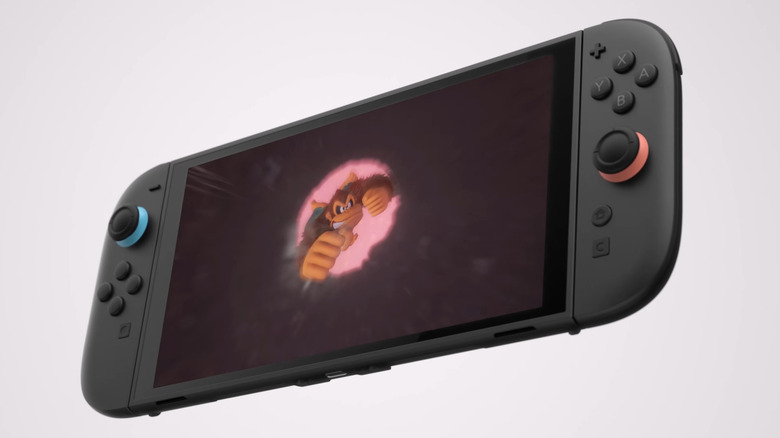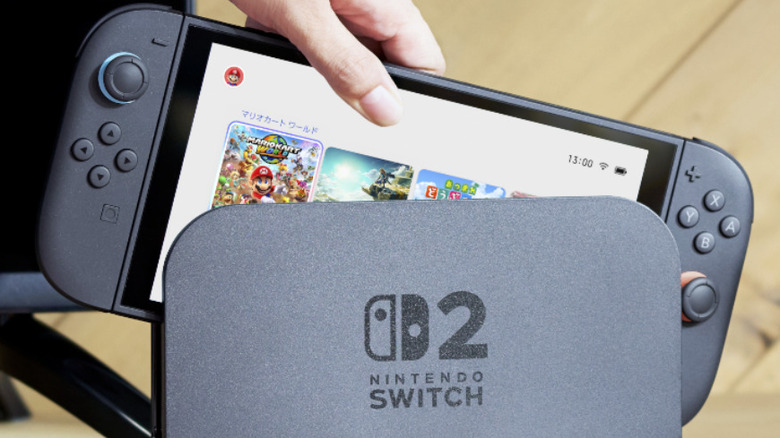What Nvidia's DLSS Feature Actually Means For Nintendo Switch 2 Users
The Nintendo Switch 2 is here, promising new titles and an upgraded experience for a host of games from the Switch's back catalog. Switch 2 owners can now enjoy Nintendo titles like "Super Mario Odyssey" and "The Legend of Zelda: Echoes of Wisdom" at a higher resolution and frame rate, thanks to the console's improved hardware. The console's upgraded hardware comes at an increased price compared to its predecessor, but it offers some significant improvements, especially in terms of graphics and performance.
One of the Switch 2's new hardware features is a custom NVIDIA processor which features a Graphics Processing Unit (GPU) alongside dedicated RT and Tensor Cores, enabling up to 4K visuals when gaming with the docked console in TV mode and up to 120 frames per second (FPS) when used as a handheld. Moreover, it uses NVIDIA G-SYNC when played in handheld mode, eliminating stutters in whichever game you're playing.
The Switch 2's Tensor Cores sharpen up graphics while you're gaming using Deep Learning Super Sampling (DLSS), a rendering technology that uses neural networks to boost a game's resolution. It upscales images to change their appearance, particularly when performance drops. The RT Cores, on the other hand, boost the Switch 2's lighting capabilities by improving the lifelikeness of shadows and reflections using ray tracing.
Nvidia's custom GPU upscales graphics and cleans up video chat
One of the Switch 2's selling points is its ability to be used as a handheld or home console. When it's docked, you can set it up through your TV or monitor to play on the big screen, which can bump up the resolution to 3840 x 2160 (4K) at 60 FPS. The Switch 2 also supports 2560 x 1440 at 120 FPS. You'll only get a maximum 1920 x 1080 resolution using the built-in 7.9-inch LCD, a noticeable step up from its predecessor.
The GPU's Tensor Cores push resolutions up to hit specific targets in different modes using DLSS. The goals it aims to hit depend on what mode your Switch 2 is set to, and how well it's performing. This means that sometimes the image might be upscaled significantly to try and achieve a target resolution, while other times it might just provide a small boost to polish things up.
Nintendo is introducing GameChat with the Switch 2, which will also take advantage of the GPU's Tensor Cores. It's an integrated video calling and screen-sharing platform that will allow you to game and chat with up to 12 of your friends remotely. If you have Nintendo's USB-C camera setup with your console, the Tensor Cores will remove your background like a built-in green screen background removal.
Which mode you play your Switch 2 in will impact image quality
Digital Foundry reported on Cyberpunk 2077's performance on the Switch 2, determining exactly how NVIDIA's custom hardware would fare when used in different modes. When used in portable mode, the GPU clock speed almost halves what it can achieve while docked, falling from 1 GHz to 0.56 GHz. When this performance drops, the DLSS feature upscales the images to create a sharper image. There are four different configurations for the Switch 2, depending on your priorities. Of course, it can be docked or used as a handheld, but it can also be set to quality or performance mode.
Quality mode offers 30 FPS, while performance offers 40 FPS. When docked, both modes aim for the same target of 1080p, but they each render differently. As the name suggests, quality mode achieves a higher resolution — between 720p and 1080p — but performance mode lands anywhere between 540p and 1080p, prioritizing the ability to hit the targeted FPS instead.
Using the console as a handheld will make the graphics vary much more due to the performance dip and lowered clock speeds. Quality mode aims to hit 810p using DLSS but can go as low as 450p. Performance mode, on the other hand, gets between 360p and 720p, using DLSS to achieve the higher end of this range. Upscaling can lead to compression artifacts and grainier images, especially when pushed to the extreme, which can in turn negatively affect the overall image quality.


